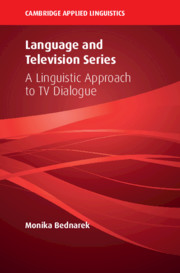Book contents
- Language and Television Series
- The Cambridge Applied Linguistics Series
- Language and Television Series
- Copyright page
- Contents
- Figures
- Tables
- Series Editors’ Preface
- Acknowledgements
- Part I Introduction
- Part II A Functional Approach to Television Series (FATS)
- Part III Data and Approaches
- Part IV Analyses of SydTV
- Part V TV Dialogue in Pedagogy
- Part VI Conclusion
- Appendix
- Endnotes
- References
- Index of TV Series
- General Index
- References
References
Published online by Cambridge University Press: 14 September 2018
- Language and Television Series
- The Cambridge Applied Linguistics Series
- Language and Television Series
- Copyright page
- Contents
- Figures
- Tables
- Series Editors’ Preface
- Acknowledgements
- Part I Introduction
- Part II A Functional Approach to Television Series (FATS)
- Part III Data and Approaches
- Part IV Analyses of SydTV
- Part V TV Dialogue in Pedagogy
- Part VI Conclusion
- Appendix
- Endnotes
- References
- Index of TV Series
- General Index
- References
- Type
- Chapter
- Information
- Language and Television SeriesA Linguistic Approach to TV Dialogue, pp. 277 - 294Publisher: Cambridge University PressPrint publication year: 2018



